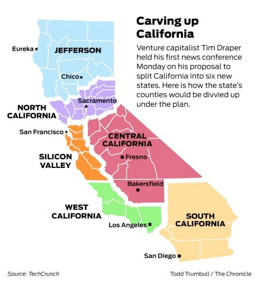DIVIDING CALIFORNIA-California has launched more than a few inventions considered utopian that were eventually adopted throughout the nation.
Some of the more famous are Sour Dough Bread, Barbie Dolls, Pet Rocks, Hula Hoops, wetsuits, theme parks, the computer mouse, and—yes—even the Martini!
But no state has ever put forth a plan to completely replace itself—until now.
Tim Draper, a multimillionaire venture capitalist, would like to do just that.
If the constitutional amendment he is proposing succeeds, it would divide the Golden State into 6 separate duchies each with its own sovereign government.
There is little doubt that Californians have strong differences about how exactly they want to be identified and what traits best epitomize their particular regional lifestyles. That diversity is part of our beauty.
There is little similarity between a Stockton cattle rancher, a business executive from Los Angeles, a hi-tech entrepreneur from Silicon Valley and a fisherman from Eureka.
Under Draper’s plan none would have to go through Sacramento any longer to address their concerns. Instead they would each have independent lawmaking bodies that would compete with their neighboring states for revenues and services.
Of course many things such as water and electric power, mass transit, highway systems, reservoirs and bridges, colleges and universities, hospitals, prisons and countless other attributes of statehood already exist and the benefits are intended to be shared.
While some residents may consider themselves disadvantaged because they come from regions that are less populous and rightfully complain they sometimes get short shrift, as separate states their political clout would only be further fractured and diminished.
Through reapportionment, which received bipartisan support, the majority of governmental entities meet the requirements of geographical contiguity and commonality of interests and this is reflected in the makeup of the legislature. Rural and urban lawmakers alike must vie for one another’s support.
 In a big vs. small state arrangement compromises would be harder to achieve and intractable conflicts would be inevitable.
In a big vs. small state arrangement compromises would be harder to achieve and intractable conflicts would be inevitable.
For example, one could envision the new state of Silicon Valley voting for reasons of regional self-interest to refuse collection of taxes assessed on out-of-state businesses under Proposition 39 which is adding billions of dollars to California’s treasury for education and energy efficiency.
Pitting less populated, agriculture-based Fresno and Stockton, bulwarks of the “Central California” under the Draper scheme, against mighty “Silicon Valley” with commercial giants, San Francisco and San Jose, at its epicenters would be comparable to Nevada dictating policy to California.
Central California with all its farms would have even less reason to negotiate with chronically water-starved Los Angeles, the southern colossus that would dominate the new state of “West California.”
As the drought-induced water wars escalate, it is not surprising that some polls show Central Valley inhabitants favoring the Draper plan. It so happens that the majority of valley residents tend to vote Republican as do many others along a large swath of territory running through the state’s interior.
Many feel disempowered since the state, for now, is in the firm control of the Democrats.
However, it was not that long ago when Republican governors ruled and the newly installed “open primary” system gives outsiders a fighting chance to get in.
Carving up the state would only accentuate these partisan divisions with little incentives for the strongest regions to reach agreements or strive for parity.
{module [862]} {module [662]}
What is more likely is a dilution of collective leverage the public has now over issues ranging from a cleaner environment and sensible water allocations to sound investments in energy alternatives and prudent fiscal planning, rebuilding a crumbling infrastructure and revitalizing a faltering educational system, reducing unemployment and effective disease control and much more.
These are daunting problems that cross territorial boundaries, affect all residents, and require financial muscle and maximum brainpower to be solved.
Draper’s fanciful notion may be appealing to those who suffer from congenital distemper regarding anything involving government. For them dividing the state into six would only be a start. For most of us his dream would quickly turn into a nightmare.
(Richard Rubin writes about political issues and is President of a public affairs management firm. This column was posted first at FoxandHoundsDaily.com)
--cw
CityWatch
Vol 12 Issue 58
Pub: Jul 18, 2014





